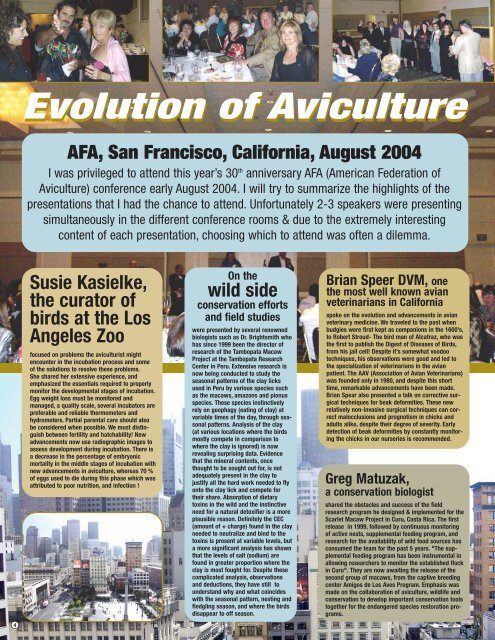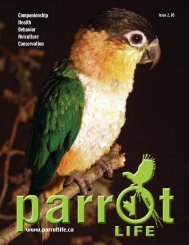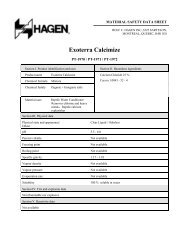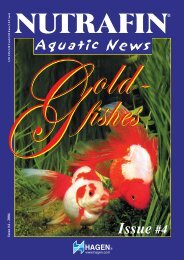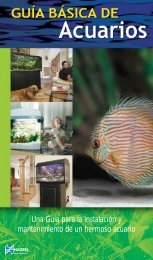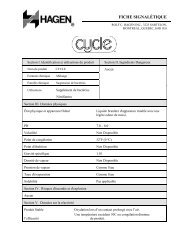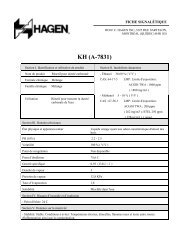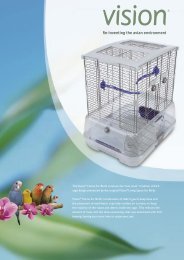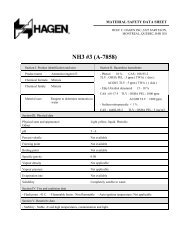parrotLife_Printers-3 (Page 1) - Rolf C. Hagen Inc.
parrotLife_Printers-3 (Page 1) - Rolf C. Hagen Inc.
parrotLife_Printers-3 (Page 1) - Rolf C. Hagen Inc.
You also want an ePaper? Increase the reach of your titles
YUMPU automatically turns print PDFs into web optimized ePapers that Google loves.
4<br />
Evolution of of Aviculture<br />
AFA, San Francisco, California, August 2004<br />
I was privileged to attend this year’s 30 th anniversary AFA (American Federation of<br />
Aviculture) conference early August 2004. I will try to summarize the highlights of the<br />
presentations that I had the chance to attend. Unfortunately 2-3 speakers were presenting<br />
simultaneously in the different conference rooms & due to the extremely interesting<br />
content of each presentation, choosing which to attend was often a dilemma.<br />
Susie Kasielke,<br />
the curator of<br />
birds at the Los<br />
Angeles Zoo<br />
focused on problems the aviculturist might<br />
encounter in the incubation process and some<br />
of the solutions to resolve these problems.<br />
She shared her extensive experience, and<br />
emphasized the essentials required to properly<br />
monitor the developmental stages of incubation.<br />
Egg weight loss must be monitored and<br />
managed, a quality scale, several incubators are<br />
preferable and reliable thermometers and<br />
hydrometers. Partial parental care should also<br />
be considered when possible. We must distinguish<br />
between fertility and hatchability! New<br />
advancements now use radiographic images to<br />
assess development during incubation. There is<br />
a decrease in the percentage of embryonic<br />
mortality in the middle stages of incubation with<br />
new advancements in aviculture, whereas 70 %<br />
of eggs used to die during this phase which was<br />
attributed to poor nutrition, and infection !<br />
On the<br />
wild side<br />
conservation efforts<br />
and field studies<br />
were presented by several renowned<br />
biologists such as Dr. Brightsmith who<br />
has since 1999 been the director of<br />
research of the Tambopata Macaw<br />
Project at the Tambopata Research<br />
Center in Peru. Extensive research is<br />
now being conducted to study the<br />
seasonal patterns of the clay licks<br />
used in Peru by various species such<br />
as the macaws, amazons and pionus<br />
species. These species instinctively<br />
rely on geophagy (eating of clay) at<br />
variable times of the day, through seasonal<br />
patterns. Analysis of the clay<br />
(at various locations where the birds<br />
mostly compete in comparison to<br />
where the clay is ignored) is now<br />
revealing surprising data. Evidence<br />
that the mineral contents, once<br />
thought to be sought out for, is not<br />
adequately present in the clay to<br />
justify all the hard work needed to fly<br />
onto the clay lick and compete for<br />
their share. Absorption of dietary<br />
toxins in the wild and the instinctive<br />
need for a natural detoxifier is a more<br />
plausible reason. Definitely the CEC<br />
(amount of + charge) found in the clay<br />
needed to neutralize and bind to the<br />
toxins is present at variable levels, but<br />
a more significant analysis has shown<br />
that the levels of salt (sodium) are<br />
found in greater proportion where the<br />
clay is most fought for. Despite these<br />
complicated analysis, observations<br />
and deductions, they have still to<br />
understand why and what coincides<br />
with the seasonal pattern, nesting and<br />
fledgling season, and where the birds<br />
disappear to off season.<br />
Brian Speer DVM, one<br />
the most well known avian<br />
veterinarians in California<br />
spoke on the evolution and advancements in avian<br />
veterinary medicine. We traveled to the past when<br />
budgies were first kept as companions in the 1600’s,<br />
to Robert Stroud- The bird man of Alcatraz, who was<br />
the first to publish the Digest of Diseases of Birds,<br />
from his jail cell! Despite it’s somewhat voodoo<br />
techniques, his observations were good and led to<br />
the specialization of veterinarians in the avian<br />
patient. The AAV (Association of Avian Veterinarians)<br />
was founded only in 1980, and despite this short<br />
time, remarkable advancements have been made.<br />
Brian Spear also presented a talk on corrective surgical<br />
techniques for beak deformities. These new<br />
relatively non-invasive surgical techniques can correct<br />
malocclusions and prognotism in chicks and<br />
adults alike, despite their degree of severity. Early<br />
detection of beak deformities by constantly monitoring<br />
the chicks in our nurseries is recommended.<br />
Greg Matuzak,<br />
a conservation biologist<br />
shared the obstacles and success of the field<br />
research program he designed & implemented for the<br />
Scarlet Macaw Project in Curu, Costa Rica. The first<br />
release in 1999, followed by continuous monitoring<br />
of active nests, supplemental feeding program, and<br />
research for the availability of wild food sources has<br />
consumed the team for the past 5 years. "The supplemental<br />
feeding program has been instrumental in<br />
allowing researchers to monitor the established flock<br />
in Curu". They are now awaiting the release of the<br />
second group of macaws, from the captive breeding<br />
center Amigos de Los Aves Program. Emphasis was<br />
made on the collaboration of aviculture, wildlife and<br />
conservation to develop important conservation tools<br />
together for the endangered species restoration programs.


